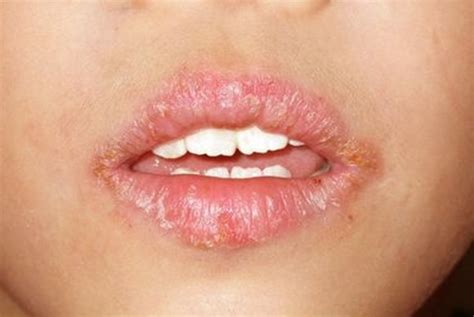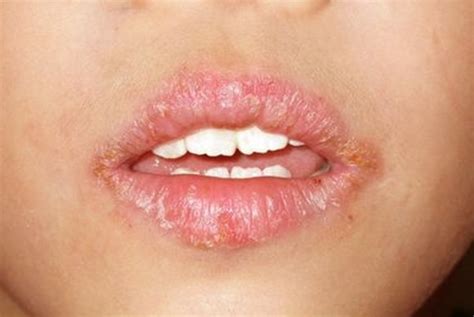

Angular cheilitis is a painful inflammation of the corners of the mouth, caused by bacterial or fungal infection and worsened by dry skin.
Angular cheilitis, also known as perleche or angular stomatitis, is a common condition that affects millions of people worldwide. This painful and unsightly inflammation occurs at the corners of the mouth and can cause discomfort when eating, speaking, and even smiling. While it may seem like a minor annoyance, angular cheilitis can have a significant impact on a person’s quality of life, leading to embarrassment, self-consciousness, and social isolation. In this article, we will explore the causes, symptoms, and treatments of angular cheilitis, as well as tips for preventing its recurrence.
Daftar Isi
Introduction
Angular cheilitis, commonly known as cracked corners of the mouth, is a common condition characterized by painful cracks or fissures at the corners of the mouth. It can affect people of all ages, but it is more prevalent among older adults and those suffering from underlying medical conditions such as diabetes, anemia, or HIV. In this article, we will explore the causes, symptoms, and treatment options for angular cheilitis.
Causes of Angular Cheilitis
Angular cheilitis can be caused by a variety of factors, including fungal or bacterial infections, nutritional deficiencies, and ill-fitting dentures. Fungal infections, particularly candidiasis, are the most common cause of angular cheilitis. Candida albicans, the fungus responsible for most cases of oral thrush, can also infect the corners of the mouth, leading to irritation, inflammation, and cracking.
Bacterial Infections
In addition to fungal infections, bacterial infections can also cause angular cheilitis. Staphylococcus aureus, a common bacterium found on the skin and in the nose, can infect the corners of the mouth, causing redness, swelling, and cracking.
Nutritional Deficiencies
Nutritional deficiencies, particularly of zinc, iron, and B vitamins, can also contribute to the development of angular cheilitis. These nutrients are essential for maintaining healthy skin and mucous membranes, and their deficiency can lead to dryness, cracking, and inflammation.
Symptoms of Angular Cheilitis
The hallmark symptom of angular cheilitis is the presence of painful cracks or fissures at the corners of the mouth. These cracks can be shallow or deep and may bleed or ooze pus in severe cases. Other symptoms may include redness, swelling, itching, and burning.
Treatment of Angular Cheilitis
Treatment for angular cheilitis depends on the underlying cause. Fungal infections can be treated with antifungal creams or oral medications, while bacterial infections may require antibiotics. Nutritional deficiencies can be corrected through dietary changes and supplements.
Topical Treatments
Topical treatments such as petroleum jelly, lanolin, or hydrocortisone cream can help soothe the symptoms of angular cheilitis and promote healing. These products should be applied to clean, dry skin several times a day until the condition resolves.
Dental Treatment
Ill-fitting dentures or other dental appliances can contribute to the development of angular cheilitis. In these cases, adjusting or replacing the appliance may be necessary to alleviate the condition.
Prevention Tips
To prevent angular cheilitis, it is important to maintain good oral hygiene, including brushing and flossing regularly and avoiding the use of harsh mouthwashes or toothpastes. A healthy diet, rich in zinc, iron, and B vitamins, can also help prevent nutritional deficiencies that may contribute to the condition.
Conclusion
Angular cheilitis can be a painful and frustrating condition, but with proper diagnosis and treatment, it can be managed effectively. If you are experiencing symptoms of angular cheilitis, consult your healthcare provider or dentist for evaluation and treatment options. By taking steps to prevent and treat this condition, you can maintain healthy, pain-free lips and mouth.Angular cheilitis is a common condition that affects millions of people worldwide. This painful and unsightly inflammation of the corners of the mouth can cause discomfort, cracking and even bleeding, making it difficult to eat, drink and speak comfortably. The most common cause of angular cheilitis is poorly fitting dentures or dental appliances that cause saliva and bacteria to accumulate in the corners of the mouth. Other contributing factors include poor oral hygiene, vitamin deficiencies, and fungal or bacterial infections. Symptoms of angular cheilitis include redness, swelling, and cracking of the corners of the mouth, which may bleed or ooze and be accompanied by pain or itching. In severe cases, the skin may become infected and cause the development of ulcers. Angular cheilitis can often be diagnosed through a physical examination by a healthcare professional, and treatment depends on the underlying cause of the condition. Prevention involves maintaining good oral hygiene and proper dental care, including wearing well-fitting dental appliances. While home remedies such as petroleum jelly or coconut oil can help alleviate symptoms, severe cases or those that do not improve with home treatment should be evaluated by a healthcare professional.Angular Cheilitis: The Painful Condition You Need to Know AboutAngular cheilitis, also known as perleche or angular stomatitis, is a common condition that causes painful cracks or sores at the corners of the mouth. While it may seem like a minor annoyance, this condition can be a sign of underlying health issues and can even lead to infection if left untreated.Pros:- Early treatment can prevent infection and further complications.- Proper diagnosis can identify underlying health issues, such as nutrient deficiencies or autoimmune disorders.- Effective treatments, such as antifungal or steroid creams, are available to alleviate symptoms and promote healing.Cons:- Misdiagnosis or delayed treatment can lead to infection and scarring.- Chronic or severe cases may require more aggressive treatment, such as oral medication or surgery.- Recurrence is common, requiring ongoing management and prevention efforts.If you are experiencing painful cracks or sores at the corners of your mouth, it is important to seek medical attention. While angular cheilitis may seem like a minor issue, proper diagnosis and treatment can prevent further complications and improve your overall health and well-being.
Angular cheilitis, also known as perleche, is a common condition that affects many people. It is characterized by painful cracks and fissures at the corners of the mouth, which can make eating, speaking, and smiling difficult. Although angular cheilitis is not a serious health problem, it can be uncomfortable and unsightly. Therefore, it is important to understand the causes, symptoms, and treatment options for this condition.
The main cause of angular cheilitis is moisture build-up in the corners of the mouth. This can happen due to a variety of factors, including poor oral hygiene, ill-fitting dentures, nutritional deficiencies, and underlying medical conditions such as diabetes or immune disorders. In addition, certain habits such as licking the lips or biting the corners of the mouth can exacerbate the problem. Symptoms of angular cheilitis include pain, redness, swelling, and cracking of the skin at the corners of the mouth. In severe cases, the skin may become infected and crusty.
If you are experiencing symptoms of angular cheilitis, it is important to seek treatment as soon as possible. Your dentist or doctor may prescribe topical or oral medications to help alleviate the pain and inflammation. In addition, they may recommend lifestyle changes such as improving oral hygiene, avoiding irritating foods or beverages, and taking nutritional supplements to boost your immune system. With proper care, most cases of angular cheilitis can be resolved within a few weeks.
In conclusion, angular cheilitis is a common condition that can be caused by a variety of factors. If you are experiencing symptoms of this condition, it is important to seek treatment from a healthcare professional. By following their advice and making appropriate lifestyle changes, you can alleviate the discomfort and restore the health of your lips. Remember, prevention is key – maintaining good oral hygiene and avoiding habits that can exacerbate the problem can help you avoid future episodes of angular cheilitis.
Visit VideoAngular cheilitis is a common condition that affects many people. It is characterized by the presence of cracks or sores at the corners of the mouth. If you are one of the many people who have questions about angular cheilitis, read on to find out more.Here are some of the most frequently asked questions about angular cheilitis:1. What causes angular cheilitis?Angular cheilitis can be caused by a number of factors, including dry skin, fungal infections, bacterial infections, and nutritional deficiencies.2. How can I prevent angular cheilitis?To prevent angular cheilitis, it is important to keep your lips moisturized and avoid licking them. You should also maintain good oral hygiene and make sure to eat a balanced diet that includes plenty of vitamins and minerals.3. Is angular cheilitis contagious?Angular cheilitis is not contagious, but it can be uncomfortable and unsightly. If you have angular cheilitis, it is important to seek treatment to alleviate your symptoms.4. What are some effective treatments for angular cheilitis?There are a number of effective treatments for angular cheilitis, including topical antifungal creams, corticosteroid creams, and oral antifungal medications. In severe cases, surgery may be necessary to remove the affected tissue.5. How long does it take for angular cheilitis to go away?The length of time it takes for angular cheilitis to go away depends on the severity of the condition and the effectiveness of the treatment. In mild cases, it may take just a few days for the sores to heal. In more severe cases, it may take several weeks or even months for the condition to fully resolve.If you are experiencing symptoms of angular cheilitis, it is important to seek medical attention to get an accurate diagnosis and appropriate treatment. With proper care, most cases of angular cheilitis can be successfully treated and resolved.






